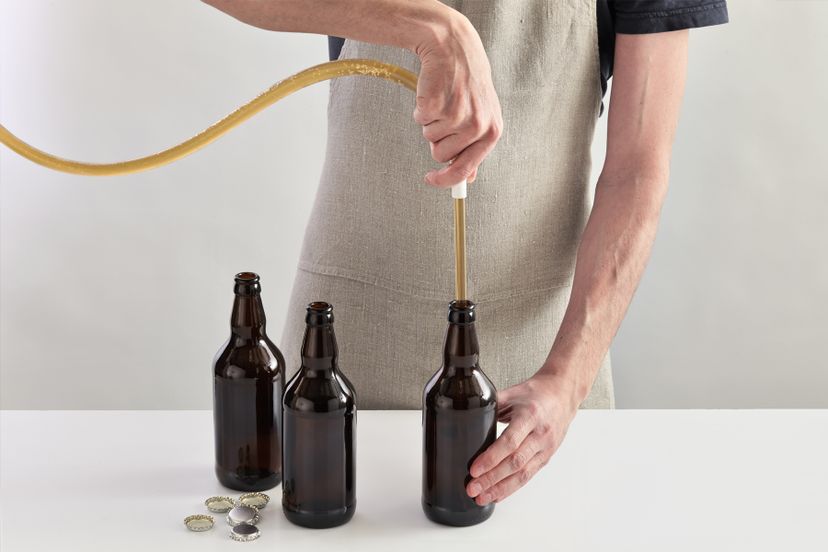The Ultimate Homebrewing Quiz
3 min

Image: Ianâ
O'Learyâ
(c)â
Dorlingâ
Kindersley/Getty
About This Quiz
There's nothing like a home science project to soothe the soul and quench your thirst. How much do you know about homebrewing?
What is yeast?
It's a special type of fungi that's essential to beer making.
In brewing, what important task does yeast perform?
converts sugar into alcohol
Without yeast, beer brewing would be a pointless endeavor.
What's one advantage to making your own yeast starter?
You'll have greater quantities of helpful bacteria.
It gives you slower and more even fermentation.
You'll know the yeast is alive.
Sometimes kits include older yeast that's no longer viable.
In addition to releasing alcohol, what else does yeast help unleash in a beer?
Beer just isn't beer if it doesn't have some fizz.
What is the purpose of mashing?
to give a beer its distinct flavor
to extract sugars from grains
It also hydrates the barley and activates the malt enzymes.
What is the single most important element to homebrewing?
Without strict cleaning processes, contaminants like bacteria will ruin your brew.
What is a primary ingredient in no-rinse sanitizer used for homebrewing?
The acid offers great sanitizing effectiveness but doesn't affect beer taste or quality.
Adding Irish moss to your wort during the last half hour of boiling does what?
Reduces haziness in the final product
Cuts down on the chances of bacterial contamination
The moss is called a "fining" in brewing; other finings might be gelatin, activated carbon and copper sulfate, among others.
What product is measured by alpha-acid units (AAUs)?
It's also called Homebrew Bitterness Units, a way to control the seasoning of your beer.
The brewing-in-a-bag process was pioneered in which country?
The technique is very effective and can be used to make as much as 12 gallons of beer.
What helps develop the characteristic taste in so-called sour beers?
Bacteria can lend all sorts of delicious flavors, including a range of sourness.
In which states was homebrewing illegal until 2013?
Both states finally legalized homebrewing in 2013, bringing them up to speed with the rest of America.
What is wort?
A skin blemish caused by exposure to beer.
The liquid that results from yeast fermentation.
The liquid that is extracted from the mashing process.
Some of the sugars that result from mashing are fermentable; some are not.
Why don't home brewers use wine bottles for their beers?
Wine bottles aren't made for carbonated beverages.
It's harder to create secondary fermentation in larger bottles.
The volume per bottle is too high considering the limited amount of beer created by most homebrewing processes.
Some brewers will use champagne bottles, though.
Compared to other beers, the fermentation temperature for lagers tends to be what?
the same as most other beers
Lagering is basically cold storage, which ultimately results in a clearer beer.
Adding hops at the start of the wort boiling process adds what to the mixture?
So if you want a really bitter beer, it all starts at the beginning.
In a homebrewing environment, what's the approximate maximum utilization of alpha acids in the finished beer?
Knowing this, you'll be better able to calculate how bitter your beer will be.
In the homebrewing process, to what does lag time refer?
The delay between bottling and the time you can drink the beer.
The delay between pitching the yeast into the wort and the start of fermentation.
The delay as you wait for the yeast to consume most simple sugars.
Long lag time doesn't necessarily mean an unsuccessful batch, but the wait can be frustrating for any brewer.
After fermentation for a lager begins, it's usually safe to drop the temperature to about what?
Much lower than that and you might stall the fermentation, which should take around two weeks.
Which molecular compound helps to produce fruity notes in a beer?
Tweaking the various compounds can completely change the flavor of a beer.
How does a hydrometer assister brewers during the process?
determining completeness of fermentation
detect optimum pH of water for the wort
A lot of brewers don't bother to use one, relying instead on experience.
Which of the following is NOT a primary factor in achieving a robust fermentation?
The yeast quality is another major factor for good fermentation.
Beer that has been pasteurized or filtered will benefit from a bit of aging.
Beer only improves with age if the yeast is still active.
Yeast can grow with or without what?
This characteristic makes yeast unusual…and very useful.
If you want to add a buttery note to a beer such as a Scotch ale, what molecular compound will be especially important?
The instability of this particular chemical, though, can quickly cause a beer to taste bad as it ages.
What does lautering do?
Blanches grains for better flavor
Crushes grains for use in brewing
Rinses sugars from spent grain
A gentle spray of warm water is used for this simple process.
If you want a brilliant-looking lager, you must lager your brew for at least how long?
That's the bare minimum, though; some brewers continue the lagering process for a year.
If your fermentation temperatures are too high, your brew might wind up with too much of what?
Too-high fermentation temperatures can cause all sorts of funky flavors to develop.
What temperature is generally considered too high for proper fermentation?
More than 75 degrees Fahrenheit
More than 65 degrees Fahrenheit
More than 85 degrees Fahrenheit
Once you break 75 degrees, your beer is likely to start tasting funny, and probably not in a good way.
homebrewing was basically illegal in the United States until what year?
Thanks to President Jimmy Carter's signature, homebrewing immediately became a popular pastime.
You Got:
/30
Ianâ
O'Learyâ
(c)â
Dorlingâ
Kindersley/Getty
